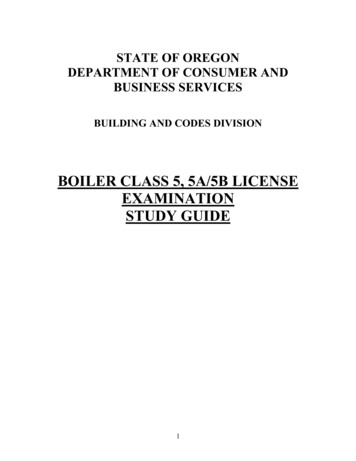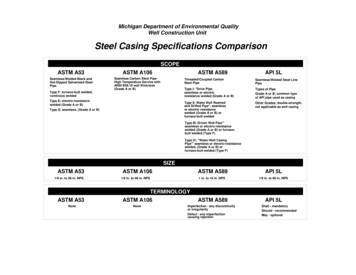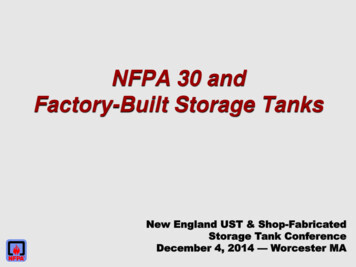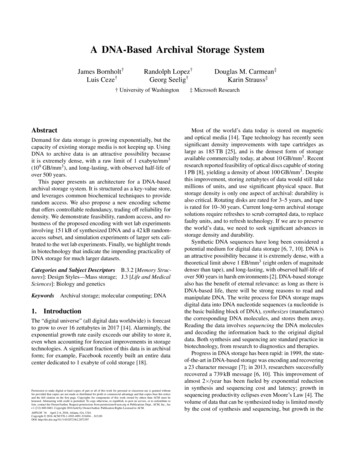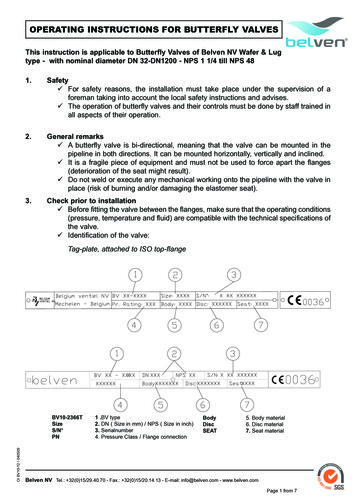
Transcription
Chapter 3STORAGEGENERAL STORAGE INFORMATIONStorage shall conform to part 55, Subpart K of Title 27 CFR (BATF). Exceptions to Title 27 CFR, otherthan more stringent regulations of local, state, or federal agencies, shall be approved by the Director of BATF(see ATF P 5400.9) dated 6/90.PERMANENT MAGAZINESPost magazines with signs reading “EXPLOSIVES-KEEP OFF.” Locate signs to minimize the possibilityof a bullet traveling in the direction of the magazine if anyone shoots at the sign.Day boxes shall not be used for permanent storage.27 CFR, SUBPART K - STORAGE55.201 GENERAL(a) Section 842(j) of the Act and 55.29 of this part requires that the storage of explosive materials must bein accordance with regulations in this part. Further, section 846 of this Act authorizes regulations toprevent the recurrence of accidental explosions in which explosive materials were involved. The storage standards prescribed by this subpart confer no right or privileges to store explosive materials in amanner contrary to state or local law.39
(b)The director may authorize alternate construction for explosives storage magazine construction that issubstantially equivalent to the standards of safety and security contained in this subpart. Any alternateexplosive magazine construction approved by the director prior to August 9, l982, will continue asapproved unless notified in writing by the director. Any person intending to use alternate magazineconstruction shall submit a letter of application to the regional director (compliance) for transmittal tothe director, specifically describing the proposed magazine. Explosive materials may not be stored inalternate magazines before the applicant has been notified that the application has been approved.(c) A licensee or permittee who intends to make changes in his magazines, or who intends to construct oracquire additional magazines, shall comply with 55.63.(d)The regulations set forth in 55.221 through 55.224 pertain to the storage of special fireworks, pyrotechnic compositions, and explosive materials used in assembling fireworks.(e) The provisions of 55.202(a) classifying flash powder and bulk solutes as high explosives are mandatoryafter March 7, l990: Provided, that those persons who hold licenses or permits under this part on thatdate shall, with respect to the premises covered by such licenses or permits, comply with the highexplosives storage requirements for flash powder and bulk solutes by March 7, l991 (Amended by TD.ATF-293, 55 FR 3722, Feb. 5, l990).CLASSES OF EXPLOSIVE MATERIALSFor purposes of this part, there are three classes of explosive materials. These classes, together with thedescription of explosive materials comprising each class, are as follows:High Explosives - Explosive materials which can be caused to detonate by means of a blasting cap whenunconfined, (for example, dynamite, emulsions, water gels, flash powders, and bulk solutes). See also 55.201.Low Explosives - Explosive materials which can be caused to deflagrate when confined, (for example, blackpowder, safety fuses, ignitor cords, fuse lighters, and “special fireworks” defined as Class B explosives by U.S.Department of Transportation regulations in 49 CFR Part 173, except for bulk solutes.)Blasting Agents - (For example, ammonium nitrate-fuel oil and certain water gels (see also 55.ll). (Amendedby TD.ATF-293, 55 FR 3722, Feb. 5, l990).TYPES OF MAGAZINESFor purposes of this part, there are five types of magazines. These types, together with the classes ofexplosive materials, as defined in 55.202, which will be stored in them, are as follows:Type 1 Magazines - Permanent magazines for the storage of high explosives, subject to the limitations prescribed by 55.206 and 55.213. Other classes of explosive materials may also be stored in type l magazines.Type 2 Magazines - Mobile and portable indoor and outdoor magazines for the storage of high explosives,subject to the limitations prescribed by 55.206, 55.208(b), and 55.213. Other classes of explosive materialsmay also be stored in type 2 magazines.Type 3 Magazines - Portable outdoor magazines for the temporary storage of high explosives while attended(for example, a “day-box”), subject to the limitations prescribed by 55.206 and 55.213. Other classes of explosive materials may also be stored in type 3 magazines.40
Type 4 Magazines - Magazines for the storage of low explosives, subject to the limitations prescribed by55.206(b), 55.210(b), and 55.213. Blasting agents may be stored in type 4 magazines, subject to the limitations prescribed by 55.206(a), 55.210(b), and 55.213.Type 5 Magazines - Magazines for the storage of blasting agents, subject to the limitations prescribed by55.206(c), 55.211(b), and 55.213.INSPECTIONINSPECTION OF MAGAZINESAny person storing explosive materials shall inspect their magazines at least every seven days. This inspection need not be an inventory, but must be sufficient to determine whether there has been unauthorizedentry or attempted entry into the magazine, or unauthorized removal of the contents of the magazines.EXPLOSIVE MATERIALS IN STORAGEAny person storing explosive materials shall inspect the magazine at least every seven days. This inspection need not be an inventory, but must be sufficient to determine whether there has been unauthorized entry orattempted entry into the magazine. Notify the nearest regional office of the Bureau of Alcohol, Tobacco andFirearms (BATF), and appropriate state offices within 24 hours of any loss, theft, or unauthorized entry into amagazine.MOVEMENT OF EXPLOSIVE MATERIALSAll explosive materials must be kept in locked magazines meeting the standards in this subpart unlessthey are:(a) In the process of manufacture;(b) Being physically handled in the operating process of a licensee or user;(c) Being used; or(d) Being transported to a place of storage or use by a licensee or permittee or by a person who has lawfullyacquired explosive materials under 55.106.LOCATION OF MAGAZINES(a) Outdoor magazines in which high explosives are stored must be located no closer to inhabited buildings,passenger railways, public highways, or other magazines in which high explosives are stored, than theminimum distances specified in the table of distances for storage of explosive materials in 55.218.(b) Outdoor magazines in which low explosives are stored must be located no closer to inhabited buildings,passenger railways, public highways, or other magazines in which explosive materials are stored, than theminimum distances specified in the table of distances for storage of low explosives in 55.219, except thatthe table of distances in 55.224 shall apply to the storage of special fireworks. The distances shown in55.219 may not be reduced by the presence of barricades.(c) (1) Outdoor magazines in which blasting agents in quantities of more than 50 pounds are stored must belocated no closer to inhabited buildings, passenger railways, or public highways than the minimum distances41
specified in the table of distances for storage of explosive materials in 55.218.(c) (2) Ammonium nitrate and magazines in which blasting agents are stored must be located no closer tomagazines in which high explosives or other blasting agents are stored than the minimum distancesspecified in the table of distances for the separation of ammonium nitrate and blasting agents in 55.220.However, the minimum distances for magazines in which explosives and blasting agents are storedfrom inhabited buildings, etc., may not be less than the distances specified in the table of distances forstorage of explosives materials in 55.218 (Amended by T.D. ATF- 293, 55 FR 3722, Feb. 5, l990).CONSTRUCTION FOR TYPE 1 MAGAZINESA type 1 magazine is a permanent structure: a building, an igloo or “army-type structure,” a tunnel, ora dugout. It is to be bullet-resistant, fire-resistant, weather-resistant, theft-resistant, and ventilated. Refer toI.M.E. Publication No. 1.CONSTRUCTION OF TYPE 2 MAGAZINESA type 2 magazine is a box, trailer, semitrailer, or other mobile facility. Refer to I.M.E. Publication No.1.Outdoor Magazines - Outdoor magazines are to be bullet-resistant, fire-resistant, weather-resistant, theftresistant, and ventilated. They are to be supported to prevent direct contact with the ground and, if less thanone cubic yard in size, must be securely fastened to a fixed object. The ground around outdoor magazinesmust slope away for drainage or other adequate drainage provided. When unattended, vehicular magazinesmust have wheels removed or otherwise effectively immobilized by kingpin locking devices or othermethods approved by the director.Indoor magazines - Indoor magazines are to be fire-resistant and theft-resistant. They need not be bulletresistant and weather-resistant if the buildings in which they are stored provide protection from the weatherand from bullet penetration. No indoor magazine is to be located in a residence or dwelling. The indoorstorage of high explosives must not exceed a quantity of 50 pounds. More than one indoor magazine maybe located in the same building if the total quantity of explosive materials stored does not exceed 50pounds. Detonators must be stored in a separate magazine (except as provided in 55.213) and the totalquantity of detonators must not exceed 5000.CONSTRUCTION OF TYPE 3 MAGAZINESA type 3 magazine is a “day box” or other portable magazine. It must be fire-resistant, weatherresistant, and theft-resistant. A type 3 magazine is to be constructed of not less than number 12-gauge(.1046) steel, lined with at east either 1/2-inch plywood or 1/2-inch Masonite-type hardboard.42
CONSTRUCTION OF TYPE 4 MAGAZINESA type 4 magazine is a building, igloo, or “army-type structure,” tunnel, dugout, box, trailer, or a semitrailer or other mobile magazine.CONSTRUCTION OF TYPE 5 MAGAZINESA type 5 magazine is a building, igloo, or “army-type structure,” tunnel, dugout, box, trailer, or a semitrailer or other mobile facility.SMOKING AND OPEN FLAMESSmoking, matches, open flames and spark producing devices are not permitted:(a) In any magazine;(b) Within 50 feet of any outdoor magazine; or(c) Within any room containing an indoor magazine.QUANTITY AND STORAGE RESTRICTIONS(a) Detonators are not to be stored in the same magazine with other explosive materials, except under thefollowing circumstances:(1) In a type 4 magazine, detonators that will not mass detonate may be stored with electric squibs, safetyfuse, igniters, and igniter cord.(2) In a type 1 or type 2 magazine, detonators may be stored with delay devices and any of the items listedin item one of this section.STORAGE WITHIN TYPES 1, 2, 3, AND 4 MAGAZINES(a) Explosive materials within a magazine are not to be placed directly against interior walls and must bestored so as not to interfere with ventilation. To prevent contact of stored explosive materials with walls,a non-sparking lattice work or other non-sparking material may be used.(b) Containers of explosive materials are to be stored so that marks are visible. Stocks of explosive materialsare to be stored so they can be easily counted and checked upon inspection.(c) Except with respect to fiberboard or other nonmetal containers, containers of explosive materials are not tobe unpacked or repacked inside a magazine or within 50 feet of a magazine, and must not be unpacked orrepacked close to other explosive materials.(d) Tools used for opening or closing containers of explosive materials are to be of non-sparking materials,except that metal slitters may be used for opening fiberboard containers. A wood wedge and a fiber,rubber, or wooden mallet are to be used for opening or closing wood containers of explosive materials.Metal tools other than non-sparking transfer conveyors are not to be stored in any magazine containing43
high explosives.LIGHTING(a) Battery-activated safety lights or battery-activated safety lanterns may be used in explosive storagemagazines.(b) Electric lighting used in any explosives storage magazine must meet the standards prescribed by the“National Electrical Code,” (National Fire Protection Association, NFPA 70-81), for the conditionspresent in the magazine at any time. All electrical switches are to be located outside of the magazineand also meet the standards prescribed by the National Electrical Code.(Figure 3-1) Report of theft or loss of explosives material form OMB-1512-0185.44
(c) Copies of invoices, work orders or similar documents which indicate the lighting complies with theNational Electrical Code must be available for inspection by ATF officers.NOTES TO THETABLE OF DISTANCES FOR STORAGE OF EXPLOSIVES (next page)(1) When two or more storage magazines are located on the same property, each magazine must complywith the minimum distances specified from inhabited buildings, railways, and highways, and, in addition, they should be separated from each other by not less than the distances shown for “Separation ofMagazines,” except that the quantity of explosives contained in cap magazines shall govern in regard(Figure 3-2) List of addresses and telephone numbers of BATF Offices.45
(Figure 3-3) Explosives Storage Magazine Condition Report.(Figure 3-4) Explosives Storage Magazine Condition Report, continued.46
(Figure 3-5) Explosives Storage Magazine Condition Report,continued.(Figure 3-6) Explosives Storage Magazine Condition Report,continued.47
(Figure 3-7) Blank Inspection and Inventory Record form.(Figure 3-8) Example of a properly filled out Inspection and Inventory Record form.48
to the spacing of said cap magazines from magazines containing other explosives. If any two or more magazines are separated from each other by less than the specified “Separation of Magazines” distances, thensuch two or more magazines, as a group must be considered as one magazine and the total quantity ofexplosives stored in such group must be treated as if stored in a single magazine located on the site of anymagazine of the group and must comply with the minimum of distances specified from other magazines,inhabited buildings, railways, and highways.(2) All types of blasting caps in strengths through No. 8 cap should be rated at 1 to 2 lbs. of explosives per1000 caps. For strengths higher than No. 8 cap, consult the manufacturer.(3) For quantity and distance purposes, detonating cord of 50 or 60 grains per foot should be calculated asequivalent to 9 lbs. of high explosives per 1000 feet. Heavier or lighter core loads should be rated proportionately.NOTES TO THE TABLE OF SEPARATION DISTANCES OF AMMONIUM NITRATE AND BLASTING AGENTS FROMEXPLOSIVES OR BLASTING AGENTS (next page)(1) This table specifies separation distances to prevent explosion of ammonium nitrate and ammonium nitratebased blasting agents by propagation from nearby stores of high explosives or blasting agents referred to inthe tables the “donor.” Ammonium nitrate, by itself, is not considered to be a donor when applying thistable.Ammonium nitrate, ammonium nitrate-fuel oil or combinations thereof are acceptors. If stores of ammonium nitrate are located within the sympathetic detonation distance of explosives or blasting agents, onehalf the mass of the ammonium nitrate is to be included in the mass of the donor.(2) When the ammonium nitrate and/or blasting agent is not barricaded, the distances shown in the table mustbe multiplied by six. These distances allow for the possibility of high-velocity metal fragments from mixers, hoppers, truck bodies, sheet metal structures, metal containers, and the like which may enclose the“donor.” Where explosives storage is in bullet resistant magazines or where the storage is protected by abullet-resistant wall, distances and barricade thicknesses in excess of those prescribed are not required.(3) These distances apply to ammonium nitrate that passes the insensitivity test prescribed in the definition ofammonium nitrate fertilizer issued by the Fertilizer Institute. Ammonium nitrate failing to pass the testmust be stored at proper separation distances.(4) These distances apply to blasting agents which pass the insensitivity test prescribed in regulations of theU.S. Department of Transportation (49CFR Part 173).(5) Earth or sand dikes, or enclosures filled with the prescribed minimum thickness of earth or sand are acceptable artificial barricades. Natural barricades, such as hills or timber of sufficient density that the surrounding exposures which require protection cannot be seen from the “donor” when the trees are bare ofleaves, are also acceptable.(6) For determining distances to be maintained from inhabited buildings, passenger railways, and public highways, use the table in 55.218.49
REPAIR OF MAGAZINESBefore repairing the interior of magazines, all explosive materials are to be removed and the interiorcleaned. Before repairing the exterior of magazines, all explosive materials must be removed if there existsany possibility that repairs may produce sparks or flame. Explosive materials removed from magazinesunder repair must be:(a) Placed in other magazines appropriate for the storage of those explosive materials under this subpart; or(b)Placed a safe distance from the magazines under repair where they are to be properly guarded and protected until the repairs have been completed.50
(Figure 3-9) Table of distances for storage of explosive materials.51
(Figure 3-10) Table of distances for storage of low explosives.(Figure 3-11) Table of distances for storage of low explosives.52
HOUSEKEEPINGMagazines are to be kept clean, dry, and free of grit, paper, empty packages and containers, andrubbish. Floors are to be regularly swept. Brooms and other utensils used in the cleaning and maintenanceof magazines must have no spark-producing metal parts, and may be kept in magazines. Floors stained byleakage from explosive materials are to be cleaned according to instructions of the explosives manufacturer. When any explosive material has deteriorated, it is to be destroyed in accordance with the advice orinstructions of the manufacturer. The area surrounding magazines is to be kept clear of rubbish, brush, drygrass, or trees (except live trees more than 10 feet tall, for not less than 25 feet in all directions. Volatilematerials are to be kept a distance of not less than 50 feet from outdoor magazines. Living foliage which isused to stabilize the earthen covering of a magazine need not be removed.INVENTORYInventories must be kept on all explosives, blasting agents, detonators, and primers, including mixedbinaries. Permanent storage inventories are maintained by the magazine operator; working field inventories are maintained by the blaster-in-charge on a daily basis. Permanent storage inventories must be bywithdrawal, return, and resupply with physical inventory checks at least monthly. Permanent storage inventory should use a “two-mode system,” with inventory sheets in each magazine and a hard-bound inventory book in the possession of the magazine operator. Magazine and field storage inventories must balanceat the start and end of each day. Inventory inconsistencies must be resolved upon discovery, with fullexplanation recorded in the hard-bound inventory book.Inventory entries must be made in ink, and include: a) date, b) material and quantity removed/returned/resupplied, c) name of person being issued or returning materials, or in case of resupply, name ofmanufacturer, d) lot number and date of manufacture, and e) name of person issuing/receiving materials.Inventories should be kept by “cartridge count” and “cap count,” not by box or carton count. “Capcount” means the count of individual detonators such as “25 MS delay caps, 100 each,” not “1/4 box 25MS delays.” “Cartridge count” means the count of individual units of explosive such as “Tovex 800, 54sticks,” or “E-Cord, 700 feet,” NOT “1/2 case Tovex 800.” Detonators, primers, and detonating cords arepackaged by unit count (each, feet, meters), resulting in a specific number of units per box or spool for agiven product; once that number is known, there is no reason to open factory-sealed boxes to obtain anaccurate count. Cartridge explosives do not share that reliability, and the contents of each case must becounted when it is opened; however, until opened, the factory seals should be left on cases and the inventory should read something like “5 cases 38 sticks” (meaning there are five sealed cases, and one openedcase containing 38 sticks, in the magazine). Blasting agents are normally inventoried by weight (pounds),but sack or bag counts may also be used.53
(Figure 3-12) Explosives Storage Magazine Condition Report form.54
STORING EXPLOSIVES IN REMOTE,UNINHABITED, ROADLESS LOCATIONSIn remote, uninhabited, roadless locations (backcountry or wilderness), store explosives and detonatorsseparately behind natural barriers in an area out of site and a safe distance from the trail, and any campsite,overlook, or other place of normal public access. Make secure from theft as is practicable. Clear away leaves,dead grass, and other flammable materials. Protect explosives from water with fire-resistant waterproofedcanvas; slope the ground to keep away surface water. Post explosives with a red-on-white warning signreading, "EXPLOSIVES-KEEP OFF" in letters at least 1-1/2" high. The sign should be placed on or againstthe explosives, but where it will be seen by anyone approaching the cache.Transport only an adequate amount of explosives to last for one work period (five or 10 days). Do notleave explosives unattended for more than 12 hours. Where practical, transport magazines by plane or helicopter.STORING FIRELINE EXPLOSIVES IN THE FIELDUsing portable type 2 (see 27 CRF part 55, page 27) magazines where possible. A type 3 (see 27 CFR part55, page 27) magazine or an explosive transport truck may be used if storage distance and attendance regulationsare adhered to and the truck is kept locked.When it is not possible to store explosives in an approved magazine, the explosives will be stored in asecured area away from the camp. If possible, store explosives behind a natural or man made barrier. Theexplosives shall be covered with a fire resistant waterproof tarpaulin and remain under constant surveillance bya guard. Post the explosives with clearly visible red-on-white warning signs reading, "EXPLOSIVES-KEEPOFF". Detonators shall never be stored with fireline explosives. In the event of a lightning storm, all personnel including the guard will move at least 1000 feet from the storage areaTWO-COMPONENT CAP SENSITIVE EXPLOSIVESStore both components in an approved magazine. An approved magazine for two-component explosives isa locked cabinet for each component. However, when mixed, it becomes a Class A explosive and must be storeaccording to CFR 27 part 55.55
56
A type 3 magazine is a “day box” or other portable magazine. It must be fire-resistant, weather-resistant, and theft-resistant. A type 3 magazine is to be constructed of not less than number 12-gauge (.104
